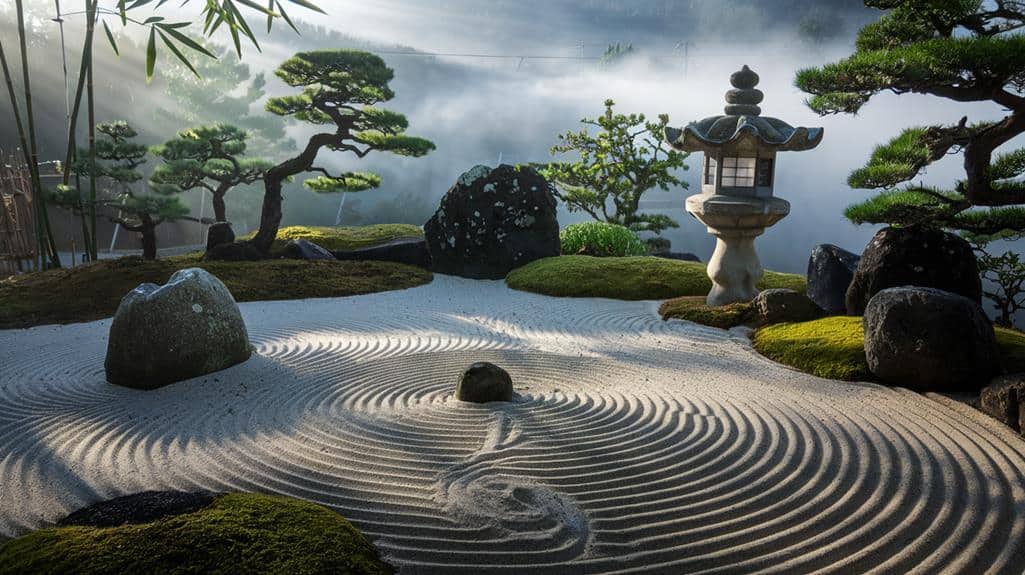14 Zen Gardens That Inspire Tranquility
You’ll discover that Zen gardens offer more than just aesthetic appeal—they’re gateways to a deeper understanding of peace and mindfulness. While the iconic Kyoto Imperial Palace Garden stands as a masterpiece of traditional design, it’s just one fragment of a larger story that spans centuries of Japanese garden philosophy. From meticulously raked gravel patterns that mirror ocean waves to thoughtfully positioned stones that anchor the spirit, these 14 sacred spaces hold secrets that can transform your approach to tranquility. Each garden presents its own meditation on the art of finding stillness in an increasingly chaotic world.
The Kyoto Imperial Palace Garden
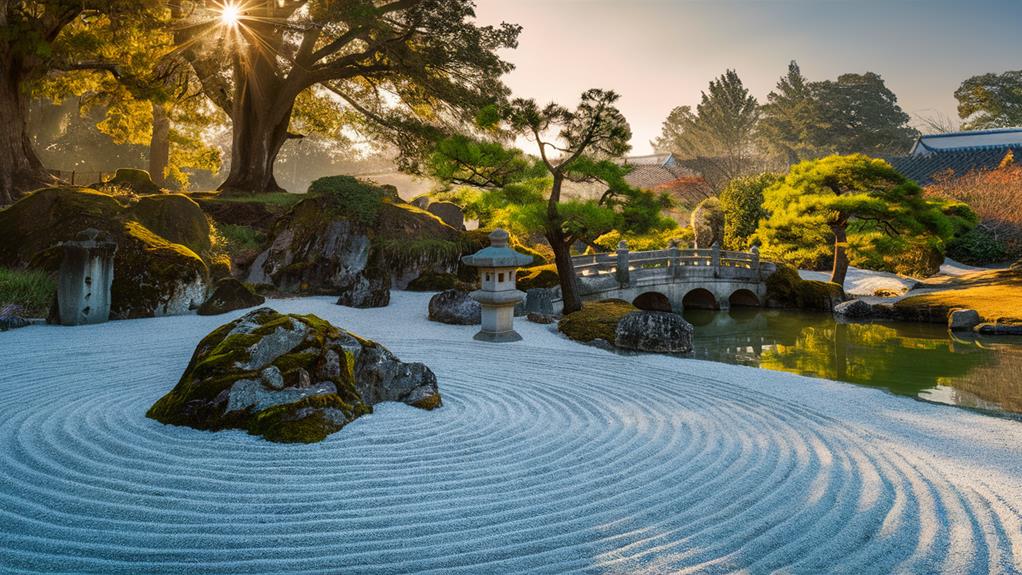
Within the ancient capital of Kyoto lies one of Japan’s most significant imperial gardens. As you walk through the towering vermillion gates, you’ll discover a masterpiece of landscape design that’s served as a sanctuary for emperors across the centuries.
The garden’s meticulous layout reveals itself through winding paths that lead you past precisely pruned pines and carefully positioned stones, each element carrying profound symbolic meaning.
You’ll find yourself drawn to the garden’s northern section, where a serene pond reflects the changing sky, its waters disturbed only by occasional koi breaking the surface. The gravel patterns, raked daily by dedicated caretakers, ripple outward like waves frozen in time. Here, you’re not merely observing – you’re participating in a centuries-old tradition of contemplative experience.
What sets this imperial garden apart is its ability to transform with the seasons while maintaining its essential character. In spring, cherry blossoms dust the paths with pink; in autumn, maple leaves paint the scene in crimson.
Yet the garden’s fundamental tranquility persists, offering you a timeless space for reflection and inner peace.
Waves of Mindful Gravel
Rippling patterns in Zen garden gravel tell stories without words, inviting you to pause and contemplate their deeper meanings.
You’ll find these carefully raked lines transforming ordinary crushed stone into flowing rivers of consciousness, each groove deliberately placed to guide your wandering mind toward stillness.
As you observe the gravel’s concentric circles expanding outward, you’re witnessing the physical manifestation of ripples in a pond – yet these waves remain forever frozen in time.
The act of creating these patterns isn’t merely decorative; it’s a meditation in motion, where each stroke of the rake becomes an expression of your present moment awareness.
You’ll notice how the gravel’s texture changes with the light, shifting from sharp clarity at noon to subtle shadows at dusk.
When you’re drawn to trace the patterns with your eyes, you’ll discover they’re leading you on a journey inward.
These precise arrangements of stone particles mirror the order we seek in our own thoughts, offering a tangible reminder that clarity often emerges from conscious, deliberate action.
The waves in the gravel become your anchor to mindfulness, transforming simple stone into a gateway to tranquility.
Moss and Stone Harmony
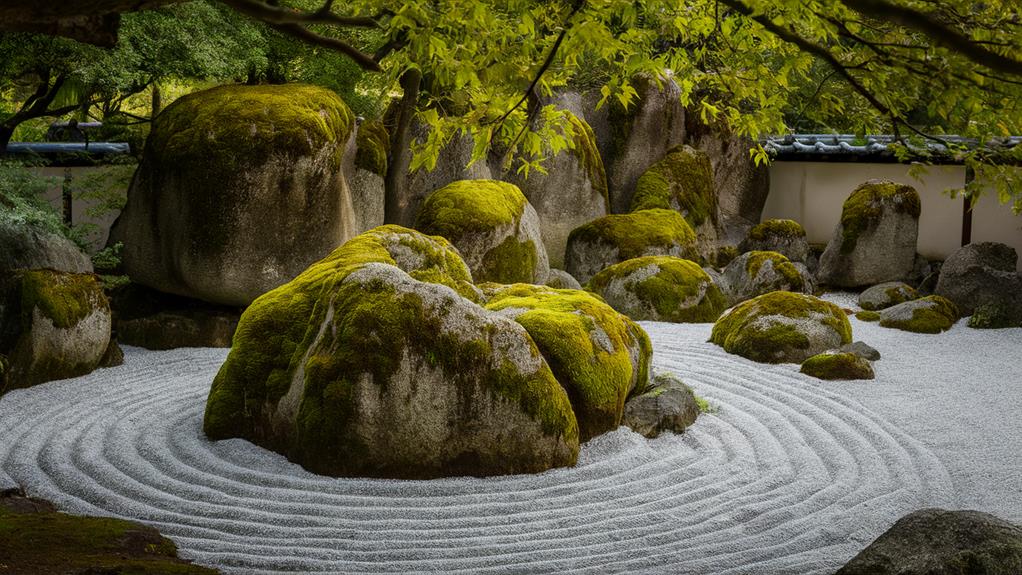
While gravel patterns speak through motion, the relationship between moss and stone whispers of stillness. You’ll discover this ancient partnership nestled within the garden’s quietest corners, where velvet-green life embraces weathered rock in a timeless dance of persistence and surrender.
Nature’s artistry unfolds as moss creeps along stone edges, softening harsh angles and transforming rigid boundaries into fluid shifts.
In your garden, you can cultivate this harmonious relationship by selecting stones that welcome their living companions. Choose rocks with natural depressions and rough textures where moss will readily take hold.
You’ll want to position them in partially shaded areas, where morning light filters through leaves and afternoon shadows provide necessary shelter. The moss won’t rush to establish itself – it’s teaching you patience, asking you to wait and observe as it slowly claims its space.
When you witness this integration of living and non-living elements, you’re experiencing a fundamental principle of Zen aesthetics: the perfect balance between action and acceptance, growth and permanence.
It’s a reminder that transformation doesn’t always require movement – sometimes it comes through the quiet persistence of being.
Minimalist Mountain Sanctuary
Mountain-inspired sanctuaries capture Zen’s essence through deliberate simplicity and elevated perspectives.
You’ll notice how these spaces draw from nature’s own architectural genius, where rugged peaks meet pristine sky in perfect harmony. Within your garden, carefully positioned rocks rise from beds of raked gravel, creating miniature mountain ranges that echo distant horizons.
You can transform your space by incorporating stepped elevations that mirror mountainous terrains, allowing your mind to ascend through different levels of consciousness.
Strategic placement of larger stones creates focal points that ground your meditation practice, while smaller elements cascade downward in a natural flow that draws your eye through the landscape.
You’ll find that bamboo screens, positioned to filter light like morning mist among mountain peaks, add depth and mystery to your sanctuary.
As you move through your mountain-inspired garden, you’re invited to pause at carefully crafted viewpoints where the interplay of height and depth evokes the profound stillness found in high altitudes.
Each element works in concert to lift your spirit above daily concerns, offering a transcendent space where earthly boundaries dissolve into pure contemplation.
Water’s Edge Meditation Space
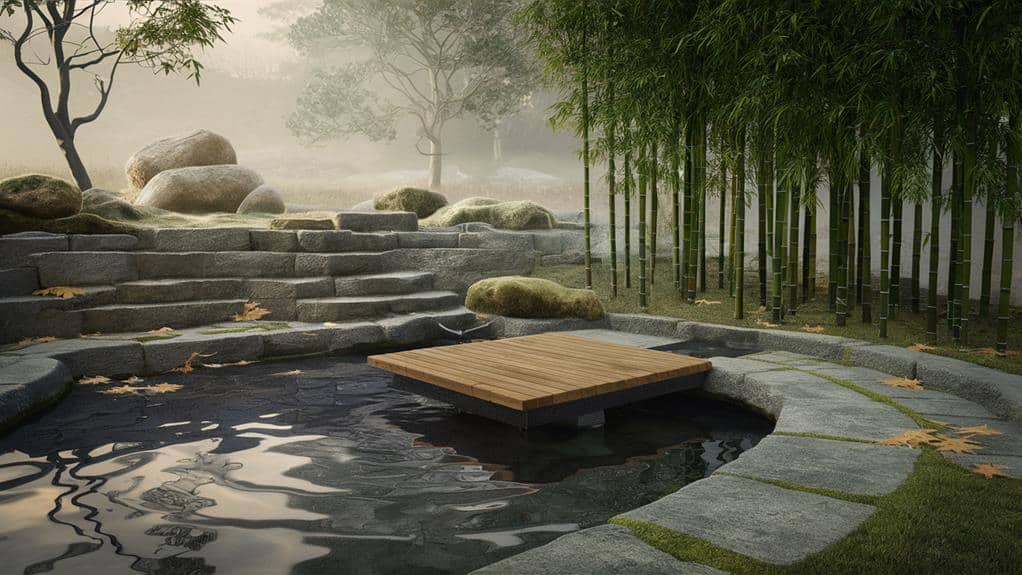
From the elevated serenity of mountain-inspired designs, the gentle flow of water beckons you toward a different kind of peace. As you approach the water’s edge meditation space, you’ll witness how rippling pools and meandering streams create an ever-shifting canvas of reflection and movement.
The careful placement of smooth river stones along shallow channels guides both water and consciousness through intentional paths of contemplation.
You’ll discover how the interplay between still pools and flowing water mirrors your own internal states – sometimes turbulent, sometimes tranquil. Position yourself near the cascading miniature waterfall, where you can watch droplets catch the light like scattered diamonds, each one carrying away a fragment of worldly concern.
The strategic positioning of meditation benches allows you to settle into the water’s rhythm, while carefully placed Japanese maples cast dancing shadows across the surface.
You’ll notice how the water’s constant motion paradoxically creates a sense of stillness within, as if time itself has slowed to match the deliberate pace of each ripple.
This fluid sanctuary becomes your anchor, teaching you that true peace isn’t found in absolute stillness, but in flowing gracefully with life’s inevitable currents.
Rock Garden of Enlightenment
Raked sand swirls around weathered stones like ripples frozen in time, inviting you to contemplate the profound simplicity of the Rock Garden of Enlightenment. Each carefully positioned stone emerges from the sea of sand like ancient thoughts rising from the depths of consciousness, creating a landscape that mirrors the quiet spaces within your own mind.
You’ll discover that these seemingly random arrangements follow precise principles of asymmetry and balance, drawing your gaze into deeper layers of meaning. As you move along the garden’s edge, you’ll notice how the patterns shift with your perspective, revealing new relationships between the stones and space.
The garden’s essence lies not in its individual elements but in the dialogue between presence and absence, form and emptiness. You’re encouraged to settle into stillness, allowing the stark beauty of this minimalist sanctuary to quiet the ceaseless chatter of daily thoughts.
In this sacred space, you’ll find that the weathered rocks and flowing lines of sand become teachers, offering wordless lessons about impermanence, harmony, and the profound peace that emerges when you embrace simplicity.
Bamboo Pathway to Peace
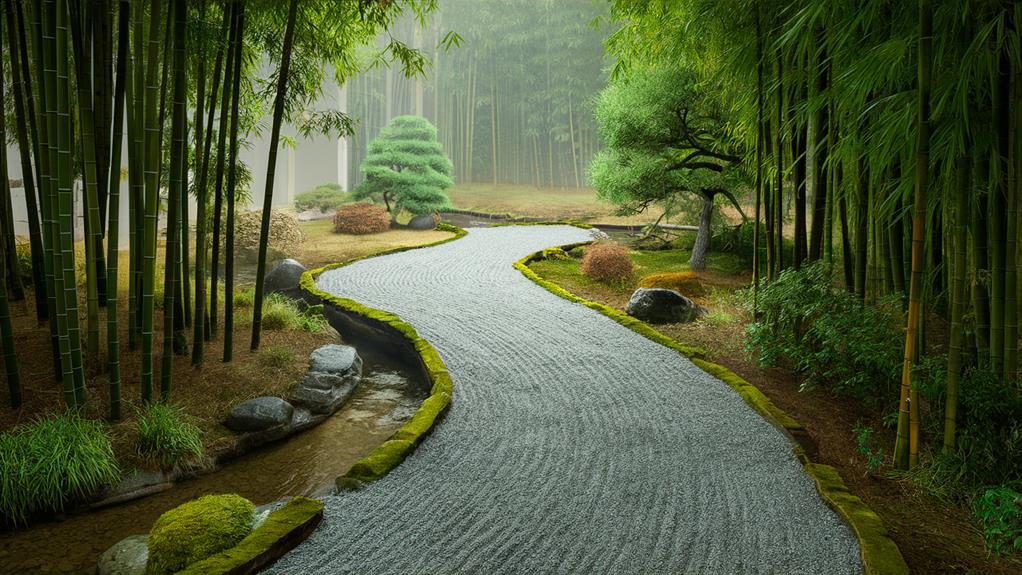
Towering bamboo stalks sway gently overhead as you follow the winding path through this tranquil corridor of green.
You’ll notice how each step along the crushed gravel creates a rhythmic crunch that anchors you to the present moment, while filtered sunlight dances through the canopy above, creating ever-shifting patterns at your feet.
As you venture deeper into the bamboo passage, you’ll discover how nature’s architecture creates a natural sanctuary.
The vertical lines of the bamboo stems draw your gaze upward, inviting contemplation of life’s infinite possibilities.
You’re walking a path that countless others have traveled before you, yet your journey remains uniquely yours.
The bamboo’s gentle rustling speaks an ancient language, reminding you that peace isn’t found in silence alone but in the subtle harmonies of the natural world.
You’ll feel the cool air beneath the dense foliage, where time seems to slow and your thoughts begin to settle like leaves on still water.
This living corridor offers more than passage from one point to another—it’s a journey into the depths of your own consciousness.
Desert Zen Oasis
Amid the stark beauty of sun-bleached stone and sculptural succulents, a desert zen garden carves out its own meditative space.
You’ll find that the arid landscape’s natural minimalism perfectly embodies zen principles, where each carefully placed rock and drought-resistant plant carries profound significance. As you walk the winding paths, you’ll discover how the interplay of sand, stone, and sky creates a contemplative atmosphere that’s distinctly different from traditional Japanese gardens.
In this sun-drenched sanctuary, you’ll notice how the desert’s inherent sparseness eliminates distractions, allowing your mind to settle into deeper states of reflection.
The geometric patterns you rake into the sand echo ancient spiritual practices, while strategically positioned boulders anchor your consciousness to the present moment. You’ll appreciate how desert-adapted plants like agave and barrel cactus create living sculptures that cast ever-changing shadows across the sand’s surface.
As the day progresses, you’ll witness how shifting light transforms the garden’s character, revealing new perspectives and insights. Here, in this fusion of desert wisdom and zen philosophy, you’ll find a uniquely powerful space for meditation and self-discovery.
Forest Meditation Grounds
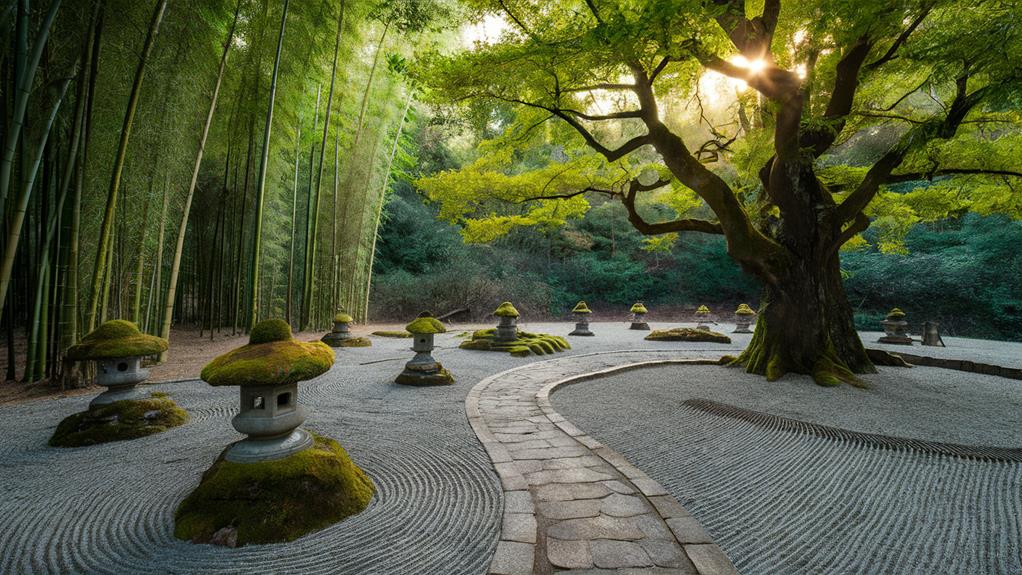
Deep within the forest’s embrace, moss-covered stones and ancient trees create a naturally meditative environment that speaks to something primordial in our souls.
You’ll find that nature has already arranged the perfect meditation space, where dappled sunlight filters through towering evergreens and deciduous canopies, creating an ever-shifting tapestry of light and shadow on the forest floor.
As you wander these sacred grounds, you’ll discover how fallen logs become natural benches, while clearings transform into perfect spots for contemplation.
You’re invited to incorporate these elements into your meditation practice: the whisper of wind through branches, the soft crunch of pine needles beneath your feet, and the distant calls of forest birds weaving a natural symphony.
You’ll notice how moss-draped rocks form natural focal points, while meandering paths guide you through spaces that seem designed for introspection.
You can enhance these forest meditation grounds by adding subtle elements: simple wooden benches, carefully placed stepping stones, or small rain shelters that blend seamlessly with the surroundings.
The key is to work with nature’s existing design, not against it.
Urban Rooftop Zen
While forest meditation spaces harness nature’s raw beauty, urban dwellers can create equally powerful sanctuaries high above the city streets. You’ll find that rooftop Zen gardens offer a transcendent escape from the concrete jungle below, where you’re free to reconnect with your inner stillness despite the urban chaos.
Through thoughtful design, you can transform your rooftop into a minimalist oasis that honors traditional Zen principles while embracing modern urban constraints.
You’ll discover that carefully arranged gravel patterns, reminiscent of flowing water, can guide your contemplative practice as effectively as any woodland stream. Strategic placement of dwarf bamboo and compact Japanese maples creates natural screens that shield you from neighboring buildings while framing views of distant skyscrapers.
By incorporating elements like stone lanterns and compact water features, you’re crafting a space that bridges the gap between ancient wisdom and contemporary living.
Your rooftop sanctuary doesn’t need to be expansive to be profound. Even in the smallest urban spaces, you can create moments of pure tranquility through the mindful arrangement of a few essential elements, allowing the sky above to become your meditation ceiling.
Sacred Stone Circles
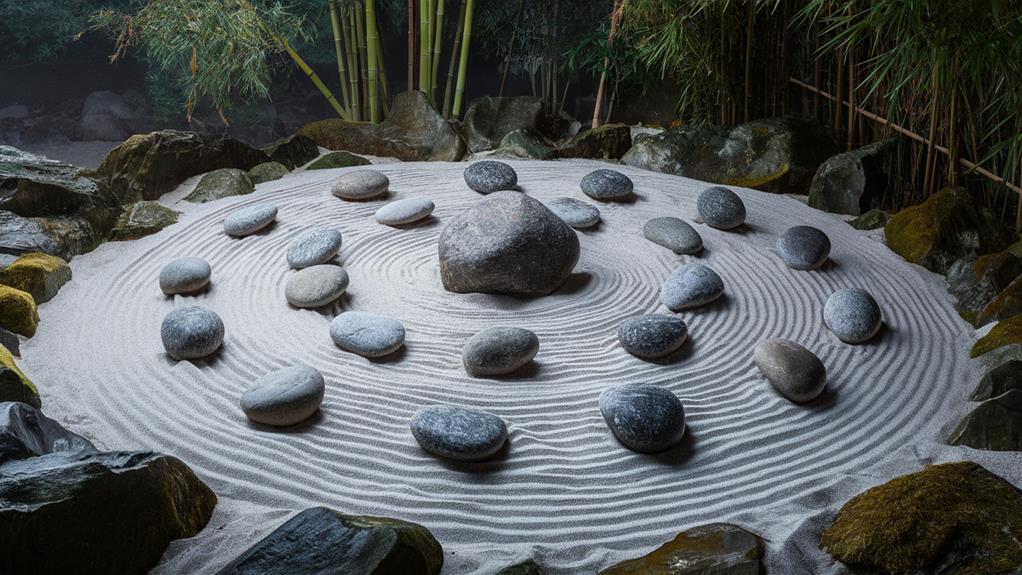
From ancient traditions to modern contemplation, sacred stone circles form the spiritual backbone of many Zen gardens. You’ll discover these carefully arranged stones creating powerful focal points that draw your consciousness inward, connecting you to both earth and sky in a dance of stillness and motion.
As you walk the perimeter, you’ll feel the intentional placement of each stone speaking to something deeper within your soul.
In your own garden, you’ll find that creating a stone circle isn’t merely about aesthetic placement – it’s about establishing a sacred space where meditation flows naturally. Select stones that call to you, varying in size and texture, but unified in their geological story.
You’ll want to position them in relation to cardinal directions, allowing the rising and setting sun to cast evolving shadows throughout the day. The spaces between stones are just as significant as the stones themselves, creating a rhythm that guides your contemplative practice.
These circles become your sanctuary, where you’ll discover that time moves differently, and the boundary between self and nature dissolves into meaningful silence.
Moonlight Garden
As moonbeams dance across pale stones and silvery foliage, your Zen garden transforms into an ethereal sanctuary after sunset.
You’ll discover how night-blooming flowers unfold their delicate petals, releasing subtle fragrances that heighten your awareness of the present moment. White-flowering plants like jasmine and moonflowers become luminous guides along your meditative path.
In this nocturnal domain, you’ll find that the interplay of shadow and light creates an ever-shifting landscape that challenges your perception of permanence.
Water features take on new significance as they reflect the moon’s glow, their gentle sounds amplified in the evening’s stillness. You’re invited to place light-colored stones and pale gravel strategically, creating paths that seem to float in the darkness.
Consider incorporating plants with silver or variegated foliage – lamb’s ear, Japanese forest grass, and artemisia – that catch and hold moonlight’s gentle radiance.
As you sit in quiet contemplation, you’ll notice how the garden’s nighttime persona offers a different kind of mindfulness practice, one where reduced visual stimulation heightens your other senses and deepens your connection to the natural world.
Seaside Sand Patterns

Rippling waves of sand in your Zen garden mirror the mesmerizing patterns found along ocean shores. As you draw your rake through the fine grains, you’ll create undulating lines that echo nature’s own rhythms, connecting you to the eternal dance of tide and time. Each stroke becomes a meditation, allowing your thoughts to ebb and flow like the sea itself.
You’ll discover that seaside sand patterns aren’t merely decorative elements; they’re visual echoes of the ocean’s endless movement. When you craft these patterns, you’re participating in an ancient dialogue between human intention and natural form. The concentric circles you create around garden stones suggest ripples spreading from raindrops, while parallel lines evoke the tide’s patient marking of the shore.
Let your rake become an extension of your spirit as you shape the sand’s surface. You’ll find that the patterns you create aren’t just designs—they’re expressions of your inner state, reflecting both turmoil and calm.
In these moments of focused creation, you’re not just arranging sand; you’re arranging your thoughts, finding order in chaos, and discovering peace in purposeful movement.
Ancient Temple Gardens
Stone lanterns cast long shadows across Japan’s ancient temple gardens, where centuries of spiritual wisdom took root in carefully curated landscapes.
You’ll find yourself drawn into these sacred spaces where every rock, tree, and pathway serves as a gateway to deeper understanding. As you walk the moss-covered stones, you’re treading the same ground where countless monks have sought enlightenment through the art of garden design.
Within these temple gardens, you’ll discover how time flows differently – measured not in minutes but in the slow drift of clouds across raked gravel seas.
You’re witnessing living artworks that have evolved over generations, where maple trees that first sprouted during the Kamakura period still reach their branches toward the sky.
These gardens aren’t just displays of horticultural mastery; they’re physical manifestations of Zen principles that you can experience with all your senses.
Each carefully positioned boulder and meticulously pruned pine tells a story of humanity’s relationship with nature, inviting you to pause and contemplate your place in the grand tapestry of existence.



